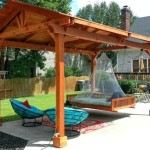Should a Patio Have a Slope in Georgia? Considering Drainage and Longevity
The decision of whether or not to incorporate a slope into a patio design in Georgia involves careful consideration of several factors, primarily related to water management and the longevity of the structure. Georgia's climate, characterized by significant rainfall throughout the year and occasional heavy downpours, necessitates effective drainage solutions to prevent water damage, erosion, and the potential for structural problems. This article examines the arguments for and against sloping a patio in Georgia, outlining the key considerations homeowners and contractors must address when planning patio construction or renovation.
A perfectly level patio, while aesthetically appealing in some instances, can quickly become a liability in a region prone to rainfall. Without a designed slope, water can pool on the surface, creating a breeding ground for mold and mildew. Furthermore, standing water can accelerate the deterioration of patio materials, particularly those susceptible to freeze-thaw cycles, even though Georgia winters are relatively mild. The accumulation of water can also lead to safety hazards, such as slippery surfaces and the potential for ice formation during colder periods. Conversely, an improperly designed slope can cause water to drain towards the house, potentially leading to foundation damage or basement flooding. Thus, a balanced approach is necessary, taking into account the specific site conditions, the type of materials used, and the overall design of the property.
The choice to slope a patio is not solely dictated by climate, but also by the intended use of the outdoor space. A patio designed for dining or entertaining might benefit from a slightly steeper slope to ensure that spills and rainwater quickly drain away from furniture and foot traffic areas. Conversely, a patio intended for relaxation or sunbathing might prioritize a less noticeable slope to maintain a more comfortable and aesthetically pleasing surface. The selection of patio materials also plays a crucial role. Porous materials like natural stone or brick may require a more pronounced slope to facilitate drainage and prevent water absorption, while less porous materials like concrete or pavers may be less susceptible to water damage and therefore require a gentler slope.
Understanding the Importance of Proper Drainage
The primary argument for incorporating a slope into a patio design in Georgia centers around the critical need for effective drainage. Proper drainage prevents water from accumulating on the patio surface, mitigating the risk of various problems. Standing water can lead to the growth of algae, mold, and mildew, creating unsightly stains and potentially posing health hazards, especially for individuals with allergies or respiratory sensitivities. Moisture penetration can also weaken the structural integrity of the patio over time, leading to cracks, crumbling, and the need for costly repairs. Furthermore, excessive moisture can attract insects, creating an unpleasant and potentially unsanitary outdoor environment.
Effective drainage is not simply about sloping the patio surface; it also involves directing the water away from the house and other vulnerable areas. This often requires incorporating drainage systems, such as French drains, catch basins, or strategically placed downspouts, to channel water away from the foundation and prevent it from pooling in the yard. The design of the drainage system should consider the existing topography of the property, the amount of rainfall typically experienced in the area, and the type of soil present. For instance, clay soils, which are common in many parts of Georgia, tend to drain slowly, necessitating a more robust drainage system than sandy soils, which drain more readily.
The gradient of the slope is also a critical factor in ensuring effective drainage. A slope that is too shallow may not provide sufficient drainage, while a slope that is too steep can create an uneven and uncomfortable surface. A generally accepted guideline is to aim for a slope of approximately 1/4 inch per foot, which provides adequate drainage without being overly noticeable. However, this gradient may need to be adjusted based on the specific characteristics of the patio materials and the surrounding landscape. Careful planning and professional installation are essential to ensure that the slope is properly graded and that the drainage system is functioning effectively.
Factors Influencing the Slope Decision: Materials and Aesthetics
The choice of patio materials significantly influences the optimal slope design. Different materials have varying levels of permeability and susceptibility to water damage. For example, natural stone, such as flagstone or slate, often has a textured surface and natural variations that can help to channel water away from certain areas. However, these materials also tend to be more porous than concrete or pavers, meaning they are more likely to absorb moisture and potentially suffer from freeze-thaw damage. Therefore, patios constructed with natural stone may require a slightly steeper slope to facilitate drainage and prevent water absorption.
Concrete patios, on the other hand, are typically less porous than natural stone and more resistant to water damage. This allows for a gentler slope, which can create a more even and comfortable surface. Pavers offer a versatile option, as they come in a variety of materials and shapes, allowing for customized drainage solutions. Permeable pavers, in particular, are designed to allow water to drain directly through the surface, reducing the need for a pronounced slope. However, the installation of permeable pavers requires careful attention to detail to ensure that the underlying drainage system is functioning properly.
Aesthetics also play a crucial role in the decision-making process. While drainage is a primary concern, homeowners also want a patio that is visually appealing and complements the overall design of their property. A subtle slope is often preferable to a steep slope, as it is less noticeable and creates a more comfortable and inviting outdoor space. However, concealing the slope requires careful planning and skilled craftsmanship. The use of subtle transitions, such as gradual changes in elevation or strategically placed landscaping features, can help to mask the slope and create a more seamless and natural look. Ultimately, the ideal slope design strikes a balance between functionality and aesthetics, ensuring effective drainage while maintaining the desired appearance.
Addressing Potential Problems with Level Patios in Georgia
While some homeowners may prefer a level patio for aesthetic reasons or perceived ease of construction, the potential problems associated with level patios in Georgia's climate often outweigh the perceived benefits. As previously mentioned, the primary concern is water accumulation, which can lead to a host of issues, including mold growth, material deterioration, and safety hazards. However, other problems can also arise from a lack of proper drainage. For example, standing water can attract mosquitoes and other pests, making the patio an unpleasant place to spend time.
Another potential problem with level patios is the risk of differential settling. Over time, the soil beneath the patio can shift and settle unevenly, leading to cracks and uneven surfaces. This is particularly common in areas with expansive clay soils, which are prone to swelling and shrinking with changes in moisture content. A slight slope can help to mitigate the effects of differential settling by allowing water to drain away from vulnerable areas and preventing the soil from becoming overly saturated. Furthermore, a properly designed slope can help to distribute weight more evenly across the patio surface, reducing the risk of cracking and settling.
If a homeowner is determined to have a level patio, it is essential to implement alternative drainage solutions to compensate for the lack of a slope. This may involve installing a comprehensive drainage system, such as French drains or catch basins, to collect and divert water away from the patio surface. The drainage system should be designed to handle the maximum amount of rainfall typically experienced in the area, and it should be regularly maintained to ensure that it is functioning properly. In addition, the patio materials should be carefully selected to ensure that they are resistant to water damage and that they are properly sealed to prevent moisture penetration. Ultimately, creating a functional and durable level patio in Georgia requires significant investment in drainage infrastructure and meticulous attention to detail.
Questions On Sloping A Raised Patio Lawn Care Forum

Great Landscaping Ideas For Your Sloped Yard In Peachtree City Georgia
Building Paver Patio On Slope Pics Lawn Care Forum

Patio Solves Slope And Shade Uac
Three Side Raised Paver Patio Help Lawn Care Forum

Sloped Backyard Case Study Under Deck Patio Fire Pit Steps

How Much Slope Should Your Patio Roof Cover Have

Sloped Backyard Case Study Under Deck Patio Fire Pit Steps

Laying Patio Pavers Polycor Inc

Laying Patio Pavers Polycor Inc
See Also








